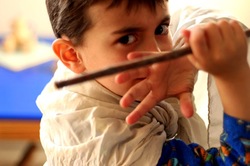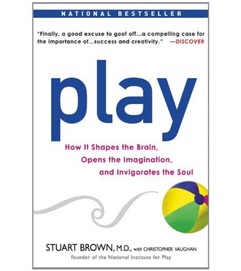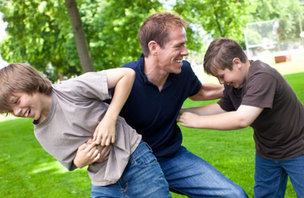|
You want to let your kids rough house. You know now the importance of that (if you missed that article click here). But you are worried about it getting out of hand. Our job as parents and teachers is to keep our children safe. But it is also to help them learn and grow. And growing involves some growing pains. How do we balance the needs for safety and challenge when our kids play rough? Last week I talked about the incredible importance of rough-and-tumble play for kids. This week we address how to tumble with our kids and to set limits when needed to keep it in that optimal risk zone (safe, but challenging and boundary-pushing). We need to balance the need for risk-taking with that for safety in three areas: their body, your body, and the environment. This week will focus on setting limits to keep your kidʼs body safe in rough-and-tumble play. Recently I was engaged in some intense foam sword fighting with two brothers in my play therapy office. The older brother loved to show off his moves and use his strength. Even though the younger brother looked overwhelmed and would sometimes get hurt, he wanted his brother to go hard on him. He needed it. In order to feel his strength he needed to be pushed to his limit. Itʼs my job to help him feel that inner strength. But it is also my job to keep him safe from harm. So imagine my dilemma when after saying he did not want his brother go easier on him, a piece of the foam sword broke off exposing the plastic underneath and grazed his neck causing a small scrape. Anxiety about if I am creating a safe enough environment for him, worry about what his parents might say, a desire to stop the game all together ran through my system in a millisecond. If I had listened to my own fear I would have stopped the game abruptly leaving him feeling weak and helpless once again. But instead I paused the game, really looked at his face that showed the pain but also strength, and asked if he would like to stop. He took a breath and said no, continuing on with a smile with his brother until they decided to stop on their own. The moral here: set limits from a place of keeping your kids safe from real danger, not from your own fear about if youʼre doing a good job. Your kids will thank you. Itʼs normal and healthy to want to protect our children. And it is true that play involves risk. But what research has shown is that allowing the natural course of some cuts and bruises and a few tears in play far exceeds the risks of cutting them off from this play (see the article on how stopping rough-and-tumble play can lead to violent tendencies). And even beyond allowing some hurts being okay, itʼs actually healing. When an adult lightly supervises rough-and-tumble play then they are there to listen to the hurts that open up when there is a cut or your child goes beyond her boundary and scares herself. All the scares or hurts from the day, the week, and even earlier in life can come out through those tears and into the loving heart of the caring adult that listens with patience and attention. This is the Hand in Hand Parenting Tool called Staylistening. So this week when you duke it out with your little ninja, remember to check in if you are setting a limit to truly keep them safe, or from your own place of worry or overwhelm.
Want tips on how to deal with your own anxiety about chaotic play? Stay tuned for next weekʼs article or sign up here! Or schedule a consultation with me.
2 Comments
 Kids need violent play. Although this statement may sound alarming (particularly form a child therapist) hear me out. Every day in my child therapy practice I hear children tell me how they weren’t allowed to pretend sword fight in school, or they can’t play superheroes, or they aren’t allowed to play tag because someone could get hurt. Although I understand teachers and parents are just trying to create peaceful environment, frankly these reports concern and upset me. I deeply want children to be able to feel safe emotionally and physically, to be kind to one another, to build healthy relationships, and to thrive in all areas … and the overwhelming evidence shows that if children are deprived of rough-and-tumble play these skills don’t develop properly.  Stuart Brown, MD is the founder of the National Institute of Play, researcher, and author. He has studied play and its effects for years. One of the most important findings he and his researchers have discovered is that when children are not allowed to engage in rough-and-tumble play (defined in his book as “play-fighting … and any activity that includes body contact among children…(including) superhero play” p.90), these children grew up to be antisocial and at times violent, including mass murderers (his first subject was the man who committed the Texas Tower Massacre). When the impulse to play was suppressed, these individuals were stripped of their natural method of learning such important social and emotional skills as empathy, boundaries, and self regulation.  In his pivotal and profound book, Play: How it Shapes Shapes the Brain, Opens the Imagination, and Invigorates the Soul Dr. Brown writes: “Research on rough-and-tumble play in animals and humans has shown that it is necessary for the development and maintenance of social awareness, cooperation, fairness, and altruism. Its nature and importance is generally unappreciated, particularly by preschool teachers or anxious parents, who often see normal rough-and-tumble play behavior such as hitting, diving, and wrestling (all done with a smile, between friends who stay friends) not as a state of play, but a state of anarchy that must be controlled.” (p.88) Parents and teachers are tasked with keeping children safe, and there is indeed risk in rough-house play. But what Dr. Brown discovered was that the benefits far outweighed the risk of scratches, hurt feelings, or even a broken bone here or there. He describes research on animal play that shows that when mammals are allowed natural play they are better able to socialize and make decisions, and those that are deprived of this play are stymied for life, unable to read social cues or deal with stress. We must help our children keep their bodies safe, but what of their spirit? We need to nourish that through this natural play as well. Empathy, the ability to set healthy boundaries, and to problem-solve stressful situations are developed when children are allowed lightly supervised rough-and-tumble play.  When a child runs after another child and pounces too hard, they get to see the effect that behavior had on their friend. The child cries, the pouncer feels bad and some part of him says, ‘I won’t do that again.’ This is how empathy is built. Brick by brick, pounce by pounce. And it’s also how boundaries are discovered and set. The child being pounced realizes what is too much and what is okay and learns how to communicate that. So the next time your child gets out his or her imaginary sword and cape, get yours out too, and let the tumbling begin. (Worried about how to set appropriate limits within rough play to keep it from crossing that line from healthy rough-housing into danger? Stay tuned for more on this next week…)  Family time, circa 2014 Family time, circa 2014 Screen time: it's something all families find themselves doing these days. In my play therapy sessions, tweens and teens love to show me their newest creations on Minecraft and trending Youtube videos. The way I see it, there is nothing inherently wrong with spending time as a family playing on devices. The internet and video games connect us in new ways. The problem is that it's all too easy to get lost in the screen. Subtle tension, anxiety, stress, and distraction are the results of losing ourselves in the screen. This is what our kids feel too when they have too much, even if they can't articulate it. So if we are stressed, distracted, and disconnected how can we bring the caring presence and attention to our families that we need in order to have harmony at home? When both we and our children are coming from a place of disconnection fights can easily erupt and everyone feels depleted.
It all starts in the body. The more awareness you have of your living, breathing body the more access you have to your prefrontal cortex and to higher level thinking, planning, and impulse control. You are more grounded, even amidst surprises and stresses, and able to choose your responses, rather than react. With adults body awareness usually starts with feeling the breath. Can you feel yourself breathing even as you read this? The breath naturally sipping in and flowing out, without any conscious effort on your part. Even as whatever else is happening around you happens, you can attend to this basic body function to stay centered in your deeper self, more relaxed and in control of your reactions. Connecting to the experience of your body or breath as you use your device can completely change what happens when it's time to get off it. The same result happens from attending to any part of the body. Try it yourself. As you read this can you feel your arms, can you sense the back of your skull, and allow it relax just a little? Can you feel your fingers as they scroll or rest? That forward and upwards tension we create when we attune to what we are doing outside of us, especially when it is mental (which most screen activities are) relaxes, and we find ourselves in our our selves again, relating to the screen, not lost in it. So the next time you are sitting with your family having some screen time try this: announce that today as everyone uses their devices they will choose one body part or the breath to feel at the same time as they have screen time. Periodically look up from your device and nonchalantly ask, "Can you feel your arms?" or "Do you notice your breath?" Let the question be an invitation, a gentle reminder, rather than anything actually needing a response. Then afterwards ask how often they were able to feel their fingers (or whatever body part they choose). Do this daily for one month, and you will not only find that you are in your own body more and less reactive, but you will notice that you will become more aware, less stressed and more alive every day. At first you may find you immediately forget to feel as you are on your screen, or that it is hard to focus on the body and the task at the same time. Like learning to play the piano with two hands, it takes time and consistent practice to build a new habit like this. With each repetition of trying to feel the body while on the screen you are helping yourself and your children grow and strengthen a neural network that supports self-regulation and centeredness in the body. Make this simple change and start a new habit that supports attention and connectedness.  So... what part of your body or breath are you going to feel during screen time today? Make of note of it in your calendar now. Go ahead, even set a reminder. Repeat daily for one month and see what shifts happen in you and in your family. |
AuthorKaren Wolfe, MFT is a psychotherapist in San Francisco and the East Bay. She is passionate about helping children and families thrive and has particular expertise with children with exceptional learning and sensory styles. Archives
August 2016
Categories
All
|
|
2354 Post St, Suite B,
San Francisco, 94115 |
3655 Grand Avenue,
Oakland, CA 94610 |
Greenwood Court,
Orinda, CA 94563 |


